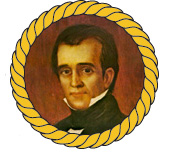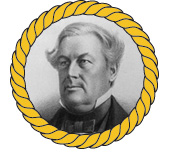









|
 |
|
| |

 |
|
Some Representatives have also served as U.S. Presidents. Eight are listed below in presidential chronological order, with the dates
that they served in the House in parentheses.
 John Quincy Adams, 6th President | Massachusetts
John Quincy Adams, 6th President | Massachusetts
(22nd-30th Congresses, 1831-1848)
John Q. Adams is the only Member to have been elected to the House
of Representatives after having served as President of the United
States. His father, John Adams, was the 2nd President of the United
States. John Quincy Adams represented the citizens of Plymouth,
Massachusetts from March 4, 1831 until his death, earning the
nickname Old Man Eloquent for his great speaking ability. He worked
to abolish slavery and opposed the House's "Gag Rule,"
which banned all debate on slavery from 1836 until 1844. On February
21, 1848, Adams suffered a stroke while sitting at his desk in
the Old House Chamber. He was taken to the Speaker's office to
recover but died there 2 days later.
 John Tyler, 10th President | Virginia
John Tyler, 10th President | Virginia
(14th-16th Congresses, 1817-1821)
In addition to serving as a Representative and the President of
the United States, John Tyler also served as a Member of the Virginia
State House of Delegates, Governor of Virginia, Senator, and Vice
President. He was born in Charles City County, VA on March 29,
1790. He attended private schools, graduated from the College
of William and Mary in 1807, and went on to study law. Tyler was
first elected to the House as a Republican and served in the 14th-16th
Congresses. As a Senator, he served as President pro tempore during
the 23rd Congress. In 1840, Tyler was elected Vice President of
the United States on the Whig ticket with William Henry Harrison
and served until the death of President Harrison April 4, 1841.
He took the oath of office as President on April 6, 1841. He did
not seek reelection. Tyler died in Richmond, VA on January 18,
1862.
 James K. Polk, 11th President | Tennessee
James K. Polk, 11th President | Tennessee
(19th-25th Congress, 1825-1839)
James K. Polk was born on November 2, 1795 near Little Sugar Creek
in Mecklenburg County, North Carolina. He moved to Tennessee in
1806 with his parents, who settled in what later became Maury
County. Polk attended public schools but was tutored privately.
He graduated from the University of North Carolina at Chapel Hill
in 1818 and went on to become a lawyer in Columbia, Tennessee.
After serving the Tennessee House and Senate, he was elected to
the 19th Congress. Polk was reelected as a Jacksonian to the
20th-24th Congresses, and then as a Democrat for the 25th Congress.
He served as Speaker of the House for the 24th-25th Congresses.
Polk then left the House to serve as Governor of Tennessee from
1839-1841. In 1844, he was elected as a Democrat as President
of the United States. He declined renomination after serving his
term. Polk died in Nashville, TN on June 15, 1849.
 Millard Fillmore, 13th President | Massachusetts
Millard Fillmore, 13th President | Massachusetts
(23rd, 25th-27th Congresses, 1833-1835, 1837-1843)
Millard Fillmore was born in Locke Township (now Summerhill) in
Cayuga County, New York on January 7, 1800. He was reared on a
farm, was largely self-taught, and apprenticed to a clothier.
He later taught school in Buffalo while studying law. After practicing
law for a few years, he was elected to the NY State assembly.
He then was elected as a Whig to the 23rd Congress and later to
the 25th-27th Congresses. He tried running for Governor of New
York as a Whig, but was unsuccessful. However, in 1848 he was
elected Vice President of the United States on the Whig ticket
headed by Zachary Taylor. Fillmore became President upon the death
of President Taylor and served from July 10, 1850, to March 3,
1853. He later tried running for president in 1852 on the Whig
ticket, and in 1856 on the National American ticket, but was unsuccessful
both times. Fillmore also commanded a corps of home guards during
the Civil War and traveled extensively. He died in Buffalo, NY
on March 8, 1874.
 Franklin Pierce, 14th President | New Hampshire
Franklin Pierce, 14th President | New Hampshire
(23rd-24th Congresses, 1833-1837)
Born in Hillsborough, New Hampshire on November 23, 1804, Pierce
attended the academies of Hancock and Francestown. He prepared
for college at Exeter and graduated from Bowdoin College in 1824.
He studied law and later was a member of the State general court.
Pierce was elected as a Democrat to the House for the 23rd-25th
Congresses. He was later elected as a Democrat to the Senate and
served 26th-28th Congresses. After completing his Senate term,
Pierce resumed the practice of law in Concord and then became
district attorney for New Hampshire. Pierce was asked by President
Polk to be Attorney General, but declined the appointment. Pierce
also served in the Mexican War as a colonel and brigadier general
and was President of the New Hampshire State constitutional convention
in 1850. Pierce was elected President of the United States on
the Democratic ticket and served from March 4, 1853-March 3, 1857.
After his presidency, he resumed practicing law. Pierce died in
Concord, N.H. on October 8, 1869.
 James Buchanan, 15th President | Pennsylvania
James Buchanan, 15th President | Pennsylvania
(17th-21st Congresses, 1821-1831)
James Buchanan was born on April 23, 1791 at Cove Gap, Pennsylvania.
He later moved to Mercersburg, PA with his parents in 1799, was
privately tutored, and attended the village academy. After graduating
from Dickinson College in 1809, he moved to Lancaster, PA and
became a lawyer. Buchanan was one of the first volunteers in the
War of 1812 and served in the defense of Baltimore. Buchanan served
his State House and then was elected to the 17th-21st Congresses.
In 1837, he was elected as a Democrat to the Senate and served
until 1845 when he resigned to accept the position as Secretary
of State in the Cabinet of President James Polk. Later, he served
as Minister to Great Britain. In 1856, Buchanan was elected as
a Democrat as President of the United States. After serving his
term, he retired to his home ‘Wheatland,’ near Lancaster,
PA where he died June 1, 1868.
 Abraham Lincoln, 16th President | Illinois
Abraham Lincoln, 16th President | Illinois
(33rd Congress, 1847-1849)
Abraham Lincoln was born in Hardin County, Kentucky on February
12, 1809. In 1816 he moved with his parents to a tract of land on Little
Pigeon Creek, Indiana, where he periodically attended a log-cabin
school, though he was also self-taught. In 1830 he moved with
his father to Illinois. There, he self-studied law and land surveying
and volunteered during the Black Hawk War. After an unsuccessful
bid for the State House, he became a merchant, then postmaster,
and then deputy county surveyor for the town of New Salem. Eventually
he was elected to the State House for 4 consecutive terms. He
also practiced law during this time. Lincoln was elected as a
Whig to the 30th Congress. He did not seek reelection and was an
unsuccessful applicant for Commissioner of the General Land Office
under President Taylor. He was given the opportunity to tender
the Governorship of Oregon Territory, but declined. Lincoln then
made 2 unsuccessful Senate bids - once has a Whig in 1855, and
then as a Republican in 1858. However, in 1860, he was elected
as President of the United States and was reelected in 1864. Lincoln
was shot by an assassin in Washington, D.C. on April 14, 1865,
and died the following day.
 Andrew Johnson, 17th President | Tennessee
Andrew Johnson, 17th President | Tennessee
(28th-32nd Congresses, 1843-1853)
Andrew Johnson was born in Raleigh, North Carolina on December
29, 1808. He was self-educated. At the age of 13 Johnson was apprenticed
to a tailor and moved to Tennessee in 1826 to be employed as a
tailor. Johnson eventually served as alderman and mayor of Greeneville,
TN and later served the Tennessee State House and Senate. He was
elected as a Democrat to the 28th-32nd Congresses and later served
as Governor of Tennessee from 1853-1857. After his governorship,
he served as a Democrat in the Senate, and in 1862 President Abraham
Lincoln appointed him Military Governor of Tennessee. He then
was elected Vice President of the United States on the Republican
ticket headed by Abraham Lincoln. Upon Lincoln's death, Johnson
became President of the United States on April 15, 1865. As President
he encountered many differences with Congress and consequently
a resolution for his impeachment passed the House of Representatives
on February 24, 1868. His impeachment trials lasted 3 months but
he was eventually acquitted by a vote of 35 to 19 (a two-thirds
vote is needed for impeachment). Upon completing his presidential
term, he retired to his home in Tennessee. He was an unsuccessful
candidate for Senate in 1869 and for the House in 1872 but he
was elected as a Democrat to the Senate in 1875, and served until
his death on July 31, 1875.
Now that you have learned about the U.S. Presidents who also served as U.S. Representatives, test your knowledge using our Study aid worksheet!
|
|
|
|
|


 John Quincy Adams, 6th President | Massachusetts
John Quincy Adams, 6th President | Massachusetts John Tyler, 10th President | Virginia
John Tyler, 10th President | Virginia James K. Polk, 11th President | Tennessee
James K. Polk, 11th President | Tennessee Millard Fillmore, 13th President | Massachusetts
Millard Fillmore, 13th President | Massachusetts Franklin Pierce, 14th President | New Hampshire
Franklin Pierce, 14th President | New Hampshire James Buchanan, 15th President | Pennsylvania
James Buchanan, 15th President | Pennsylvania Abraham Lincoln, 16th President | Illinois
Abraham Lincoln, 16th President | Illinois Andrew Johnson, 17th President | Tennessee
Andrew Johnson, 17th President | Tennessee